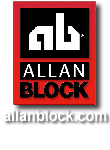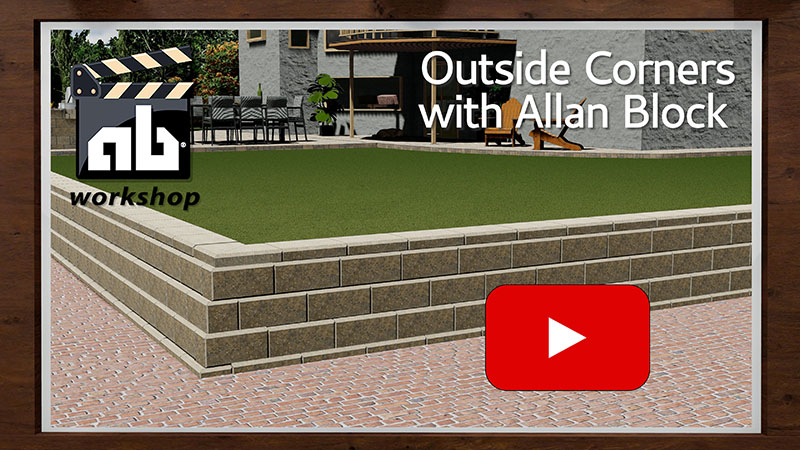Retaining Wall Corners
Corners typically require custom cutting of the blocks. Try to design curves instead. Angled retaining walls are not as stable as curved retaining walls, so whenever possible we recommend using curves instead of corners for a smooth flowing look to your landscape. If you need to use corners in your design, follow the instructions below:
Corners with AB or AB Europa Collection
If you are building with AB Fieldstone that uses recycled materials, go to Fieldstone installation
Inside Corners
AB Blocks are easily modified to build inside corners. To construct an inside corner, you will remove part of the raised lip on one block on each course.
- Use a saw with a diamond blade or a chisel to remove half of the raised front lip. This allows the next course to be installed on a level surface.
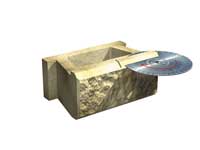
Remove raised front lip of block
- Lay the modified block perpendicular to another AB unit. This creates the corner. Level, backfill and compact.
- On the next course, remove the opposite half of the lip of an AB unit and position it over the right angle corner.
- On each successive course, simply reverse the position of the modified block to obtain an interlocked corner.Level, backfill and compact each course.
- Cut caps at 45 degree angles to complete the inside corner and give the retaining wall a custom finished look. It's a good idea to secure caps with a high strength construction adhesive once they are all cut.
More options for finishing your retaining wall.
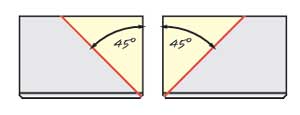
Cut caps at 45 degree angles
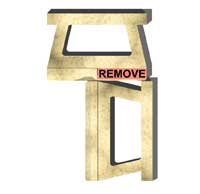
Remove raised front lip from block
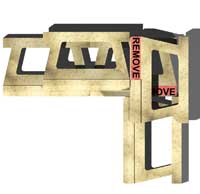
Remove part of raised front lip from block
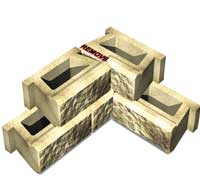
Modify retaining wall blocks to make corner
Outside Corners

Start building at the corner to keep blocks in alignment
AB Corner Blocks are used to build outside 90° corners. To construct an outside corner, you will use an AB Corner Block on every course, alternating a right and left hand corner for each course.
- Start construction of all walls at the corner. This will keep the block alignment within the 3 in. (75 mm) overlap required.
- Place an AB Corner Block at the corner. Place AB Blocks to build the base course working out from the corner in both directions (Step 1). Level, backfill and compact.
- On the 2nd course place an alternating AB Corner Block. Again work out from the corner in both directions. Level, backfill and compact (Step 2).
- Repeat this procedure, alternating every other course with AB Corner Blocks. Leveling, backfilling, and compacting as the wall grows (Step 3).
- Cut caps at 45 degree angles to complete the inside corner and give the retaining wall a custom finished look. It's a good idea to secure caps with a high strength construction adhesive once they are all cut.
More options for finishing your retaining wall.

Cut caps at 45 degree angles
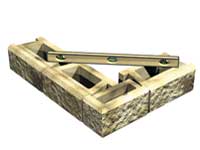
Place corner block and build out in both directions
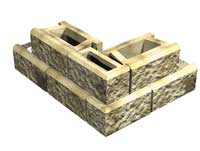
Alternate the corner block direction
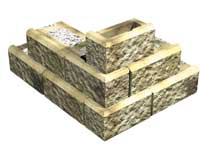
Finish wall with capstones
Altering AB Corner Blocks for Different Setbacks
AB Corner Blocks are manufactured with a 12° setback. With some minor adjustments, the blocks can be modified to work with any setback. To modify the block for a 6° setback, cut a notch on the short side of the block 0.75 in. (20 mm) deep.

For a 6° setback, make a horizontal cut 0.75 in.(20 mm) deep

Remove this piece after cut is made
Corners with Reinforcement
Corners with Geogrid
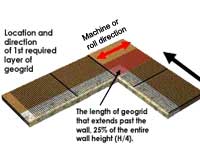
Geogrid on Inside 90° Corners
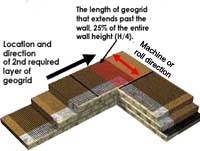
Geogrid on Inside 90° Corners
Installing Geogrid on Inside 90° Corners
On inside corners additional geogrid is required to extend past the end of the retaining wall, 25% of the completed wall height (H/4).
- Cut geogrid to required lengths per the approved plan. As a general rule the length of the geogrid needs to extend a minimum of 25% of the retaining wall height past the end of the inside corner.
- Install the layer of geogrid with the geogrid extending past the inside corner.
- Alternate the next layer of geogrid to extend the past the inside corner in the opposite direction.
Example
Finished retaining wall height is 12 ft. (3.7 m), divide by 4 which equals 3 ft. (0.9 m).The length the grid will need to extend past the corner is 3 ft. (0.9 m).
Installing Geogrid on Outside 90° Corners
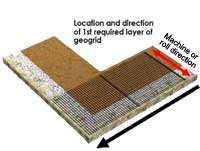
Geogrid on Outside 90° Corners
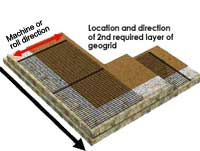
Geogrid on Outside 90° Corners
Geogrid must always be installed with its strong direction perpendicular to the face of the retaining wall. To accomplish this with 90° outside corners:
- Cut geogrid to required lengths per the approved plans
- Install geogrid to the outside corner with the roll direction running back into the excavated site.
- On the next course of block, lay the next layer of grid perpendicular to the previous layer.
Corners With AB Fieldstone Walls
One of every four AB Fielstone facing units double as corner blocks. One side is textured similar to the face.The built-in corner within the 812 facing units make it easy to create corners within the project.
Inside Corners with AB Fieldstone
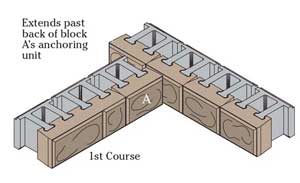
AB Fieldstone inside corner 1st course
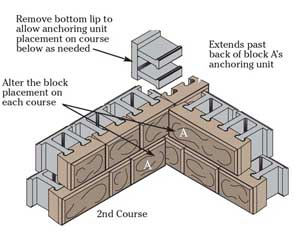
AB Fieldstone inside corner 2nd course
By alternating the block’s placement on each course of the retaining wall, an inside corner can be installed. The 824 facing units are ideal for this task, but 812 facing units are acceptable.
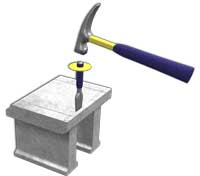
Remove lip from AB Fieldstone block
- To create a 90° inside corner, begin by placing an AB Fieldstone facing unit (A) at the corner. Then lay a second facing unit (B) perpendicular to the first. This second unit (B) must extend past the back of the first facing unit (A). Continue laying out the rest of the base course working from the corner out in both directions. Install the anchoring units.
- On additional courses alternate the placement of the facing units. Remove the lip from the anchoring unit, where the anchoring unit sits on the facing unit below as needed.
- Cut caps at 45 degree angles to complete the inside corner and give the wall a custom finished look.
More options for finishing your retaining wall.
Outside Corners with AB Fieldstone

AB Fieldstone outside corner
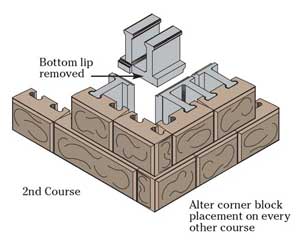
AB Fieldstone outside corner

AB Fieldstone retaining wall with corners
Some of the AB Fieldstone facing units are manufactured with a textured side that compliments the facing unit. Besides being used as a standard block, these blocks can be used to create a corner. To create a left or right hand corner simply flip the facing unit as needed to change the direction.
- Whenever possible, begin your retaining wall at the corner. Install a facing unit with the textured end facing out at the corner. Install an additional facing unit perpendicular to create a corner. Install additional facing units in both directions to continue down the wall. Check for level.
- Starting at the corner and working out in both directions, use anchoring units to span the first two facing units in each direction. Both of these anchoring units will need to be modified slightly. On the base course and above remove the wing from one anchoring unit. From course two and above, remove part of the lip off the other anchoring unit so that it fits on top of the course below. More information on modifying an anchoring unit.
- Use half of an anchoring unit on either side of the spanning anchoring units to get pattern back to each facing unit having its own anchoring unit.
- Align the lip and notch of the anchoring units in each direction to ensure proper placement of next wall course.
- Cut caps at 45 degree angles to complete the outside corner and give the wall a custom finished look.
More options for finishing your retaining wall.

